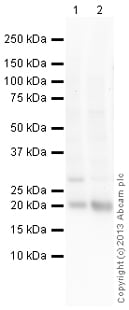Anti-alpha A Crystallin/CRYAA antibody (ab139503)
Key features and details
- Rabbit polyclonal to alpha A Crystallin/CRYAA
- Suitable for: WB
- Reacts with: Human
- Isotype: IgG
Overview
-
Product name
Anti-alpha A Crystallin/CRYAA antibody
See all alpha A Crystallin/CRYAA primary antibodies -
Description
Rabbit polyclonal to alpha A Crystallin/CRYAA -
Host species
Rabbit -
Tested Applications & Species
See all applications and species dataApplication Species WB Human -
Immunogen
Synthetic peptide corresponding to Human alpha A Crystallin/CRYAA aa 150 to the C-terminus (C terminal) conjugated to keyhole limpet haemocyanin.
Database link: P02489 -
Positive control
- This antibody gave a positive signal in Human Brain and Spinal Cord tissue lysates.
-
General notes
This product was previously labelled as alpha A Crystallin
Properties
-
Form
Liquid -
Storage instructions
Shipped at 4°C. Store at +4°C short term (1-2 weeks). Upon delivery aliquot. Store at -20°C or -80°C. Avoid freeze / thaw cycle. -
Storage buffer
pH: 7.40
Preservative: 0.02% Sodium azide
Constituent: PBS
Batches of this product that have a concentration Concentration information loading...
Concentration information loading...Purity
Immunogen affinity purifiedClonality
PolyclonalIsotype
IgGResearch areas
Associated products
-
Compatible Secondaries
-
Isotype control
-
Recombinant Protein
Applications
The Abpromise guarantee
Our Abpromise guarantee covers the use of ab139503 in the following tested applications.
The application notes include recommended starting dilutions; optimal dilutions/concentrations should be determined by the end user.
GuaranteedTested applications are guaranteed to work and covered by our Abpromise guarantee.
PredictedPredicted to work for this combination of applications and species but not guaranteed.
IncompatibleDoes not work for this combination of applications and species.
Application Species WB HumanAll applications MouseRatChimpanzeeGorillaOrangutanApplication Abreviews Notes WB Use a concentration of 1 µg/ml. Detects a band of approximately 20 kDa (predicted molecular weight: 20 kDa).Notes WB
Use a concentration of 1 µg/ml. Detects a band of approximately 20 kDa (predicted molecular weight: 20 kDa).Target
-
Function
May contribute to the transparency and refractive index of the lens. -
Involvement in disease
Defects in CRYAA are a cause of cataract autosomal dominant (ADC) [MIM:604219]. Cataract is an opacification of the crystalline lens of the eye that frequently results in visual impairment or blindness. Opacities vary in morphology, are often confined to a portion of the lens, and may be static or progressive. In general, the more posteriorly located and dense an opacity, the greater the impact on visual function. Cataract is the most common treatable cause of visual disability in childhood. -
Sequence similarities
Belongs to the small heat shock protein (HSP20) family. -
Post-translational
modificationsO-glycosylated; contains N-acetylglucosamine side chains.
Deamidation of Asn-101 in lens occurs mostly during the first 30 years of age, followed by a small additional amount of deamidation (approximately 5%) during the next approximately 38 years, resulting in a maximum of approximately 50% deamidation during the lifetime of the individual.
Phosphorylation on Ser-122 seems to be developmentally regulated. Absent in the first months of life, it appears during the first 12 years of human lifetime. The relative amount of phosphorylated form versus unphosphorylated form does not change over the lifetime of the individual. -
Cellular localization
Cytoplasm. Nucleus. Translocates to the nucleus during heat shock and resides in sub-nuclear structures known as SC35 speckles or nuclear splicing speckles. - Information by UniProt
-
Database links
- Entrez Gene: 1409 Human
- Entrez Gene: 12954 Mouse
- Entrez Gene: 24273 Rat
- Omim: 123580 Human
- SwissProt: P02489 Human
- SwissProt: P24622 Mouse
- SwissProt: P24623 Rat
- Unigene: 184085 Human
see all -
Alternative names
- Acry 1 antibody
- Alpha crystallin A chain antibody
- Alpha-crystallin A chain antibody
see all
Images
-
All lanes : Anti-alpha A Crystallin/CRYAA antibody (ab139503) at 1 µg/ml
Lane 1 : Brain (Human) Tissue Lysate - adult normal tissue
Lane 2 : Spinal Cord (Human) Tissue Lysate - adult normal tissue
Lysates/proteins at 10 µg per lane.
Secondary
All lanes : Donkey Anti-Rabbit IgG H&L preadsorbed (ab97081) at 1/10000 dilution
Developed using the ECL technique.
Performed under reducing conditions.
Predicted band size: 20 kDa
Observed band size: 20 kDa
Additional bands at: 28 kDa (possible non-specific binding)
Exposure time: 30 secondsThis blot was produced using a 4-12% Bis-tris gel under the MES buffer system. The gel was run at 200V for 35 minutes before being transferred onto a Nitrocellulose membrane at 30V for 70 minutes. The membrane was then blocked for an hour using 5% Bovine Serum Albumin before being incubated with ab139503 overnight at 4°C. Antibody binding was detected using an anti-rabbit antibody conjugated to HRP, and visualised using ECL development solution.
Datasheets and documents
References (0)
ab139503 has not yet been referenced specifically in any publications.
Images
-
All lanes : Anti-alpha A Crystallin/CRYAA antibody (ab139503) at 1 µg/ml
Lane 1 : Brain (Human) Tissue Lysate - adult normal tissue
Lane 2 : Spinal Cord (Human) Tissue Lysate - adult normal tissue
Lysates/proteins at 10 µg per lane.
Secondary
All lanes : Donkey Anti-Rabbit IgG H&L preadsorbed (ab97081) at 1/10000 dilution
Developed using the ECL technique.
Performed under reducing conditions.
Predicted band size: 20 kDa
Observed band size: 20 kDa
Additional bands at: 28 kDa (possible non-specific binding)
Exposure time: 30 secondsThis blot was produced using a 4-12% Bis-tris gel under the MES buffer system. The gel was run at 200V for 35 minutes before being transferred onto a Nitrocellulose membrane at 30V for 70 minutes. The membrane was then blocked for an hour using 5% Bovine Serum Albumin before being incubated with ab139503 overnight at 4°C. Antibody binding was detected using an anti-rabbit antibody conjugated to HRP, and visualised using ECL development solution.










